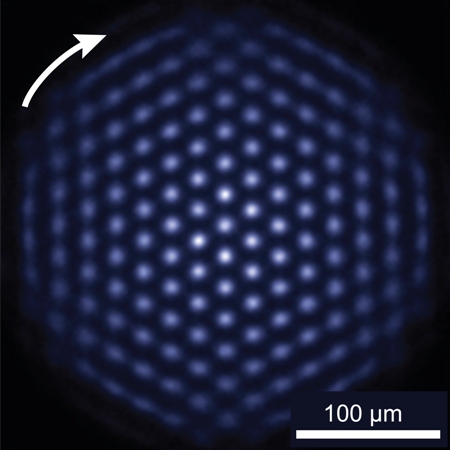A research team from the National Institute of Standards and Technology (NIST) has developed a quantum simulator capable of engineering interplays between hundreds of qubits, a 10-fold increase when compared to earlier devices.
 The NIST quantum simulator permits study of quantum systems that are difficult to study in the laboratory and impossible to model with a supercomputer. In this photograph of the crystal, the ions are fluorescing, indicating the qubits are all in the same state. Under the right experimental conditions, the ion crystal spontaneously forms this nearly perfect triangular lattice structure. (Credit: Britton/NIST)
The NIST quantum simulator permits study of quantum systems that are difficult to study in the laboratory and impossible to model with a supercomputer. In this photograph of the crystal, the ions are fluorescing, indicating the qubits are all in the same state. Under the right experimental conditions, the ion crystal spontaneously forms this nearly perfect triangular lattice structure. (Credit: Britton/NIST)
The NIST quantum simulator has qualified several key benchmarking tests and holds potential to study material science challenges that cannot be simulated on traditional computers. It comprises a single-plane crystal of below 1-mm-diameter and composed of hundreds of beryllium ions suspended inside a Penning trap. Each ion’s outermost electron behaves like a microscopic quantum magnet and is utilized as a qubit.
During the benchmarking experiments, the NIST team cooled the ions by laser beams to near absolute zero, and made the qubit to interact for simulating the materials’ quantum behavior by selectively timing microwave and laser pulses. The behavior of the two systems was engineered to be identical mathematically even if the systems looked different externally. In this fashion, simulators enable scientists to change parameters like atomic lattice geometry and spacing that cannot be varied in natural solids. The team deliberately weakened the strength of the interactions in the experiments to retain the simplicity of the simulation so that it can be verified by a conventional computer. The team uses stronger interactions in the ongoing research.
Quantum simulators harness superposition, a quantum mechanics property in which a quantum particle is made to exist in two different states concurrently. Hence, for three qubits, eight states are available concurrently. Here, the number exponentially grows with the count of qubits. The NIST quantum simulator can also coax qubit entanglement, thus enabling close interconnection between particles that are physically separated.